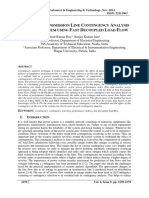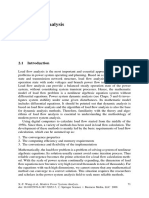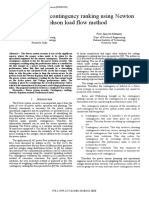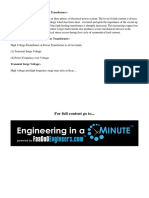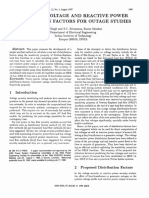Chapter 3: Power System Contingency Analysis: 3.1 Overview
Chapter 3: Power System Contingency Analysis: 3.1 Overview
Uploaded by
Vitthal PatnechaCopyright:
Available Formats
Chapter 3: Power System Contingency Analysis: 3.1 Overview
Chapter 3: Power System Contingency Analysis: 3.1 Overview
Uploaded by
Vitthal PatnechaOriginal Description:
Original Title
Copyright
Available Formats
Share this document
Did you find this document useful?
Is this content inappropriate?
Copyright:
Available Formats
Chapter 3: Power System Contingency Analysis: 3.1 Overview
Chapter 3: Power System Contingency Analysis: 3.1 Overview
Uploaded by
Vitthal PatnechaCopyright:
Available Formats
Chapter 3: Power System Contingency Analysis
3.1 Overview
Contingency analysis is one of the most important tasks encountered by the
planning and operation engineers of bulk power system. Power system
engineers use contingency analysis to examine the performance of the system
and to assess the need for new transmission expansions due to load increase or
generation expansions. In power system operation contingency analysis assists
engineers to operate at a secured operating point where equipment are loaded
within their safe limits and power is delivered to customers with acceptable
quality standards. Real time implementation of power system analysis and
security monitoring is still a challenging task for the operators.
In general the state of the system is determined on the basis of ability to meet
the expected demand under all levels of contingencies. The objective of
contingency analysis is to find voltage violations or line overloads under such
contingencies and to initiate proper measures that are required to alleviate
these violations. Exhaustive load flow calculations are involved in ascertaining
these contingencies and determining the remedial actions. The necessity for
such tool is increasingly critical due to the emerging complexity of power
systems that results from network expansions and the fact that the power
systems are pushed to operate at their limits due to financial and
environmental constraints.
The different methods used for analyzing these contingencies are based on full
AC load flow analysis or reduced load flow or sensitivity factors. But these
methods need large computational time and are not suitable for on line
applications in large power systems. It is difficult to implement on line
contingency analysis using conventional methods because of the conflict
between the faster solution and the accuracy of the solution.
METHODS OF CONTINGENCY ANALYSIS
There are various methods used for contingency analysis purpose. Methods
based on AC power flow calculations are considered to be deterministic
methods which are accurate compared to DC power flow methods. In
deterministic methods line outages are simulated by actual removal of lines
instead of modeling. AC power flow methods are accurate but they are
computationally expensive and excessively demanding of computational time.
Because contingency analysis is the only tool for detecting possible overloading
conditions requiring the study by the power system planner computational
speed and ease of detection are paramount considerations. A brief description
of these methods is given below.
DC LOAD FLOW METHOD OF CONTINGENCY ANALYSIS
This method is based on DC power flow equation to simulate single or multiple
contingencies. These equations are N-1 in number, where N is the number of
buses. In this method the line resistances are neglected, only real power flows
are modeled ignoring the reactive power flows. This results in a linear model of
the network to facilitate performing multiple contingency outages using the
principle of super position.
Each transmission line is represented by its susceptance Bij.
Impedance
Inverse of impedance
In this method only the real part of the power flow equations are considered,
that is the effect of reactive power Q is neglected and all the bus voltages are
assumed to be 1 p.u. the matrix B' is computed on the basis that all the
resistances are zero from equation
Where xij is the reactance of the line connecting buses i and j.
The angles and real powers are solved by iterating Equation
Z-MATRIX METHOD OF CONTINGENCY ANALYSIS
This method makes use of bus impedance matrix associated with both base case
system and the system modified by either line removals or additions [22]. Z-matrix
of a system can be obtained by inverting the bus admittance matrix or it can be
constructed by using available algorithms. The fundamental approach to
contingency analysis using z-matrix method is to inject a fictitious current in to
one of the buses associated with the element to be removed, of such value that the
current flow through the element equals the base case flow; all the other bus
currents are set equal to zero. In effect, this procedure creates throughout the
system a current flow pattern that will change in the same manner as the current
flow pattern in the AC load flow solution when the element in question is removed.
This method is more accurate compared to DC load flow method and the results
are comparable to those obtained using AC power flow.
You might also like
- 39.ME Remote Control SystemDocument400 pages39.ME Remote Control SystemManh DoanNo ratings yet
- Flight Simulator X RewardsDocument20 pagesFlight Simulator X RewardsWingtipGlider0% (1)
- Etihad RailDocument8 pagesEtihad RailMuhammad AbidNo ratings yet
- As NZS 1841.1-2007 Portable Fire Extinguishers General RequirementsDocument9 pagesAs NZS 1841.1-2007 Portable Fire Extinguishers General RequirementsSAI Global - APAC0% (1)
- OCPS Unit 5Document15 pagesOCPS Unit 520EPS0701No ratings yet
- Datos e Ideas Importantes, Por FechaDocument8 pagesDatos e Ideas Importantes, Por FechaLuis EspinozaNo ratings yet
- PSA AssignmentDocument52 pagesPSA AssignmentNelvin TiongNo ratings yet
- Load Flow, Contingency Analysis, State Estimation and Optimal Operation For Ieee 14-Bus SystemDocument7 pagesLoad Flow, Contingency Analysis, State Estimation and Optimal Operation For Ieee 14-Bus SystemVitthal PatnechaNo ratings yet
- Contingency Ranking and Analysis Using Mipower: Shahnawaaz Shaikh, Vijayalaxmi LingaraddiDocument5 pagesContingency Ranking and Analysis Using Mipower: Shahnawaaz Shaikh, Vijayalaxmi LingaraddiVitthal PatnechaNo ratings yet
- I T L C A P S F D L F: Mproved Ransmission INE Ontingency Nalysis IN Ower Ystem Using AST Ecoupled OAD LOWDocument12 pagesI T L C A P S F D L F: Mproved Ransmission INE Ontingency Nalysis IN Ower Ystem Using AST Ecoupled OAD LOWEngidaw Abel HailuNo ratings yet
- Establishing Contingency Analysis With FACTS Devices Using Power World SimulatorDocument18 pagesEstablishing Contingency Analysis With FACTS Devices Using Power World SimulatorNasr GhanmiNo ratings yet
- Power System AnalysisDocument22 pagesPower System AnalysisBhavesh KaushalNo ratings yet
- 23I17-IJAET1117331 v6 Iss5 2159-2170Document13 pages23I17-IJAET1117331 v6 Iss5 2159-2170MiguelOriellNo ratings yet
- Enhancement of Power System Security With Contingency Technique by Using SSSCDocument7 pagesEnhancement of Power System Security With Contingency Technique by Using SSSCEngidaw Abel HailuNo ratings yet
- Synopsis On Power Sysytem Fault AnalysisDocument12 pagesSynopsis On Power Sysytem Fault AnalysisAmulya PathakNo ratings yet
- Selección de ContingenciasDocument2 pagesSelección de ContingenciasLuis EspinozaNo ratings yet
- Capsa Resserech PaperDocument3 pagesCapsa Resserech PaperAbhishek RanjanNo ratings yet
- Analisis de Contirngencia Usando SincrofasorDocument6 pagesAnalisis de Contirngencia Usando SincrofasorLuis Azabache AnhuamanNo ratings yet
- Group No-13Document31 pagesGroup No-13Krupal RathodNo ratings yet
- Application of ETAP TM eTraX TM Software Package F PDFDocument7 pagesApplication of ETAP TM eTraX TM Software Package F PDFSatish KumarNo ratings yet
- Voltage StabilityDocument5 pagesVoltage StabilityAadyaNo ratings yet
- Voltage Stability Constrained Available Transfer Capability Calculation Using MatlabDocument11 pagesVoltage Stability Constrained Available Transfer Capability Calculation Using Matlabpralay royNo ratings yet
- Centers Use Supervisory Control and Data Acquisition' (SCADA), Where The Data IsDocument7 pagesCenters Use Supervisory Control and Data Acquisition' (SCADA), Where The Data Isswathi_grenNo ratings yet
- Wjaets 2024 0121Document17 pagesWjaets 2024 0121Mohammad Wasib AzimiNo ratings yet
- Submitted To:: Lab ReportDocument5 pagesSubmitted To:: Lab ReportsakibNo ratings yet
- Load Flow Analysis For A 220KV Line - Case StudyDocument12 pagesLoad Flow Analysis For A 220KV Line - Case StudyNmg KumarNo ratings yet
- Short Circuit Currents.Document11 pagesShort Circuit Currents.Shiju Kp.No ratings yet
- Loss ReductionDocument35 pagesLoss Reductionsolomon nchor akansakeNo ratings yet
- Flow StudiesDocument5 pagesFlow StudiesSARITHA SNo ratings yet
- 9609 PDFDocument13 pages9609 PDFnaghamNo ratings yet
- Student Member, Ieee, S.N. Member, IEEEDocument4 pagesStudent Member, Ieee, S.N. Member, IEEEDhaval MerNo ratings yet
- Study of Linear Models in Steady State Load Flow Analysis of Power SystemsDocument6 pagesStudy of Linear Models in Steady State Load Flow Analysis of Power SystemsAbdulrahmanNo ratings yet
- Load Flow Analysis PDFDocument58 pagesLoad Flow Analysis PDFfathonixNo ratings yet
- Rudy 4Document16 pagesRudy 4Fahroel ZeenNo ratings yet
- Thyristor Controlled Series Capacitor FAIR COPY 1234Document66 pagesThyristor Controlled Series Capacitor FAIR COPY 1234senthil_k23No ratings yet
- Optimal Placement of Dg-Voltage Stability and Losses-Our Project PaperDocument8 pagesOptimal Placement of Dg-Voltage Stability and Losses-Our Project PaperPavanhr4uNo ratings yet
- Thesis On Power System PDFDocument6 pagesThesis On Power System PDFvxjtklxff100% (2)
- Load Estimation For Distribution Systems With Minimum InformationDocument15 pagesLoad Estimation For Distribution Systems With Minimum InformationAhmad HamoudaNo ratings yet
- Computer Methods in Power Systems U3 & U4Document34 pagesComputer Methods in Power Systems U3 & U4Mi HgkdbNo ratings yet
- Voltage Control in Power SystemsDocument15 pagesVoltage Control in Power SystemsAshok PalakondaNo ratings yet
- Homer Brown Cap 7Document50 pagesHomer Brown Cap 7DANILO HANS MARQUES DE LIMANo ratings yet
- Electrical Engineering Engineering Computer Techniques in Power System Analysis Load Flow Studies NotesDocument36 pagesElectrical Engineering Engineering Computer Techniques in Power System Analysis Load Flow Studies NotesAnonymous HuHbq4ORNo ratings yet
- Progress Report of Minor ProjectDocument32 pagesProgress Report of Minor ProjectVaibhav DahiyaNo ratings yet
- Review Paper On Three Phase Fault AnalysisDocument6 pagesReview Paper On Three Phase Fault AnalysisPritesh Singh50% (2)
- Usefulness of DC Power Flow For Active Power Flow AnalysisDocument6 pagesUsefulness of DC Power Flow For Active Power Flow AnalysiscodeboyjimmyNo ratings yet
- Session1A - Load Flow AnalysisDocument16 pagesSession1A - Load Flow AnalysisAhmad YasserNo ratings yet
- Load Flow Analysis-1Document80 pagesLoad Flow Analysis-1mahesh100% (1)
- Contingency Evaluation For Voltage Security Assessment of Power SystemsDocument4 pagesContingency Evaluation For Voltage Security Assessment of Power Systemssmriti_hunny5969No ratings yet
- Fast Determination of Simultaneous Available Transfer Capability (ATC)Document6 pagesFast Determination of Simultaneous Available Transfer Capability (ATC)Circuit ControlarNo ratings yet
- Determination of Power System Voltage Stability Using Modal AnalysisDocument7 pagesDetermination of Power System Voltage Stability Using Modal Analysiswvargas926No ratings yet
- Contingency IndexDocument7 pagesContingency IndexRico YudhiantoNo ratings yet
- PS2 - Unit 2 (NR)Document39 pagesPS2 - Unit 2 (NR)nithyanagraj2004No ratings yet
- Case StudyDocument98 pagesCase Studyeltafbehnam93No ratings yet
- M.V.Suganyadevi, C.K.Babulal, Regular Paper Fast Assessment of Voltage Stability Margin of A Power SystemDocument12 pagesM.V.Suganyadevi, C.K.Babulal, Regular Paper Fast Assessment of Voltage Stability Margin of A Power SystemvnrsamyNo ratings yet
- Barras PilotoDocument5 pagesBarras Pilotofernando tipanNo ratings yet
- Power System Analysis-1Document28 pagesPower System Analysis-1Diyar Muhammad KhanNo ratings yet
- Menaa 2107274 ReportDocument13 pagesMenaa 2107274 Reportabir menaaNo ratings yet
- Load Flow Analysis of Jamshoro Thermal Power Station (JTPS) Pakistan Using Matlab ProgrammingDocument5 pagesLoad Flow Analysis of Jamshoro Thermal Power Station (JTPS) Pakistan Using Matlab ProgrammingTabishNo ratings yet
- New Design of Intelligent Load Shedding Algorithm Based On Critical Line Overloads To Reduce Network Cascading Failure RisksDocument15 pagesNew Design of Intelligent Load Shedding Algorithm Based On Critical Line Overloads To Reduce Network Cascading Failure RisksNirmal mehtaNo ratings yet
- Power System Contingency Ranking Using Newton Raphson Load Flow MethodDocument4 pagesPower System Contingency Ranking Using Newton Raphson Load Flow MethodHemang PatelNo ratings yet
- IJSRET V7 Issue4 497Document4 pagesIJSRET V7 Issue4 497NikolaNo ratings yet
- Investigation of the Usefulness of the PowerWorld Simulator Program: Developed by "Glover, Overbye & Sarma" in the Solution of Power System ProblemsFrom EverandInvestigation of the Usefulness of the PowerWorld Simulator Program: Developed by "Glover, Overbye & Sarma" in the Solution of Power System ProblemsNo ratings yet
- Simulation of Some Power System, Control System and Power Electronics Case Studies Using Matlab and PowerWorld SimulatorFrom EverandSimulation of Some Power System, Control System and Power Electronics Case Studies Using Matlab and PowerWorld SimulatorNo ratings yet
- LinkedIn Group Technical DiscussionsDocument5 pagesLinkedIn Group Technical DiscussionsVitthal PatnechaNo ratings yet
- Service Portfolio - System ProtectionDocument2 pagesService Portfolio - System ProtectionVitthal PatnechaNo ratings yet
- Check and Inspect The Surrounding Area of The Workplace and Check, If Any Honeybee or Any Other Hazards Stop Work and Inform The Area OperatorDocument4 pagesCheck and Inspect The Surrounding Area of The Workplace and Check, If Any Honeybee or Any Other Hazards Stop Work and Inform The Area OperatorVitthal PatnechaNo ratings yet
- RDG Gas Development ProjectDocument4 pagesRDG Gas Development ProjectVitthal PatnechaNo ratings yet
- MOM of E&T Meeting Held On 23rd July'19Document1 pageMOM of E&T Meeting Held On 23rd July'19Vitthal PatnechaNo ratings yet
- Testing Record Sheet of ELCBDocument2 pagesTesting Record Sheet of ELCBVitthal PatnechaNo ratings yet
- Islanding ReportDocument15 pagesIslanding ReportVitthal PatnechaNo ratings yet
- External Faults in Power TransformerDocument1 pageExternal Faults in Power TransformerVitthal PatnechaNo ratings yet
- TA Reimbursement Form PDFDocument1 pageTA Reimbursement Form PDFVitthal PatnechaNo ratings yet
- Backup Protection of TransformerDocument1 pageBackup Protection of TransformerVitthal PatnechaNo ratings yet
- Contingency Analysis in Smart Grid Power SystemDocument45 pagesContingency Analysis in Smart Grid Power SystemVitthal PatnechaNo ratings yet
- Contingency Ranking For Voltage Stability Analysis of Large-Scale Power SystemsDocument8 pagesContingency Ranking For Voltage Stability Analysis of Large-Scale Power SystemsVitthal PatnechaNo ratings yet
- Matlab Programe For DesertationDocument19 pagesMatlab Programe For DesertationVitthal PatnechaNo ratings yet
- Implementation of Line Stability Index For Contingency Analysis and Screening in Power SystemsDocument6 pagesImplementation of Line Stability Index For Contingency Analysis and Screening in Power SystemsVitthal PatnechaNo ratings yet
- Singh1997 PDFDocument9 pagesSingh1997 PDFVitthal PatnechaNo ratings yet
- Improved Sensitivities in MW Dispatch For Control of VoltageDocument7 pagesImproved Sensitivities in MW Dispatch For Control of VoltageVitthal PatnechaNo ratings yet
- New Desert 1Document86 pagesNew Desert 1Vitthal PatnechaNo ratings yet
- Kyasanur Forest DiseaseDocument11 pagesKyasanur Forest DiseasesurabhisprNo ratings yet
- Case Study No. 1 - GRP 7 (9.41PM)Document13 pagesCase Study No. 1 - GRP 7 (9.41PM)Shuu SanNo ratings yet
- Chapter 26 - Capacitance: Physics 4B Lecture NotesDocument6 pagesChapter 26 - Capacitance: Physics 4B Lecture NotesAnkit WalNo ratings yet
- Msds CPD SikaLatex UsDocument8 pagesMsds CPD SikaLatex UsmastercssiNo ratings yet
- Haematology Basic Screening Package Complete Blood Count (CBC EXT)Document6 pagesHaematology Basic Screening Package Complete Blood Count (CBC EXT)Anil PeshinNo ratings yet
- 30 Contoh Soal Narrative Materi Bahasa InggrisDocument8 pages30 Contoh Soal Narrative Materi Bahasa InggrisMuhamad MahdyNo ratings yet
- Feeler Gages: Range (Inch) Thickness of Leaves (Inch) Accuracy (Inch) No. of Leaves Insize No. CodeDocument11 pagesFeeler Gages: Range (Inch) Thickness of Leaves (Inch) Accuracy (Inch) No. of Leaves Insize No. Coderonald allan liviocoNo ratings yet
- Skolnik Chapter 10 1 TextDocument38 pagesSkolnik Chapter 10 1 TextVikas PassiNo ratings yet
- Field Issues in PV Modules - PDFDocument5 pagesField Issues in PV Modules - PDFPaavalan gNo ratings yet
- Module 1: Creation Spirituality: Why Do We Need To Care God's Creation?Document8 pagesModule 1: Creation Spirituality: Why Do We Need To Care God's Creation?Philip Wenceslao DelgueraNo ratings yet
- Wien Bridge Oscillator DesignDocument16 pagesWien Bridge Oscillator DesignReece RevosaNo ratings yet
- Latour "Charles Péguy: Time, Space and Le Monde Moderne"Document23 pagesLatour "Charles Péguy: Time, Space and Le Monde Moderne"adeenameyNo ratings yet
- AMT 211-4, Ignition - Group 2, QuestionnairesDocument2 pagesAMT 211-4, Ignition - Group 2, QuestionnairesEarl Michaelo R. KalacasNo ratings yet
- Chloride Ion Migration/diffusion Through Concrete and Test MethodsDocument30 pagesChloride Ion Migration/diffusion Through Concrete and Test Methodsrekcah ehtNo ratings yet
- Digital Electronics Lab Worksheet 1: Subject Code: 21ECH-101 AimDocument15 pagesDigital Electronics Lab Worksheet 1: Subject Code: 21ECH-101 AimRavinder singhNo ratings yet
- Taylor's Theorem - WikipediaDocument13 pagesTaylor's Theorem - WikipediaJasonNo ratings yet
- 1.1 Graphs and Graphing UtilitiesDocument3 pages1.1 Graphs and Graphing UtilitiesdiscostukesNo ratings yet
- Postnatal Assessment ProcedureDocument4 pagesPostnatal Assessment ProcedureApex College of Nursing100% (2)
- Notes by Alakh PandeyDocument9 pagesNotes by Alakh Pandeyirfanalirind181No ratings yet
- The Beginner's Guide To Intermittent Fasting - and The Fascinating Science Behind This Hip Biohacking ToolDocument18 pagesThe Beginner's Guide To Intermittent Fasting - and The Fascinating Science Behind This Hip Biohacking ToolWilson Gayo100% (1)
- Techniques and Indices For Preventive Maintenance OptimizationDocument6 pagesTechniques and Indices For Preventive Maintenance OptimizationGopi SubramaniamNo ratings yet
- Yr 9 Textiles Workbook - 2023Document95 pagesYr 9 Textiles Workbook - 2023SawyerNo ratings yet
- Stenflex - GR Sae1 2H21Document2 pagesStenflex - GR Sae1 2H21françois MNo ratings yet
- Tamil Nadu 11th Standard HistoryDocument138 pagesTamil Nadu 11th Standard HistoryIndia History Resources100% (5)
- GROUP 4 - Critique PaperDocument2 pagesGROUP 4 - Critique PaperPrince Lawrence CobradoNo ratings yet









